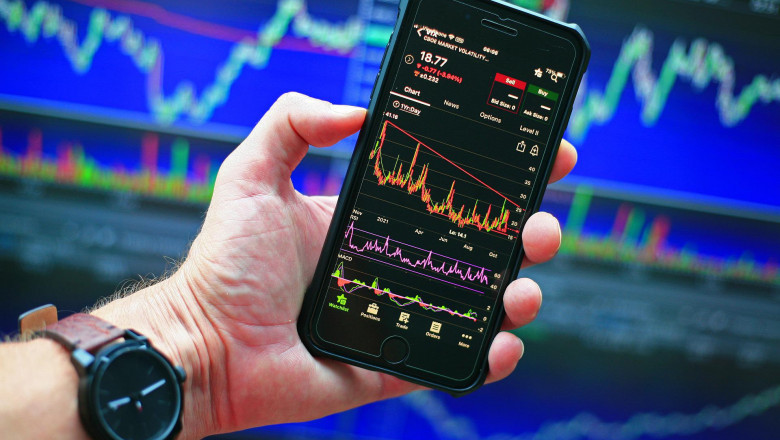views

The term "market manipulation" refers to any effort made to artificially affect the price of an asset or the behavior of the markets. Even though crypto exchanges have grown more suspicious of market manipulators, it is still very important to recognize typical tendencies to detect possible bad actors. Monitoring and preventing market manipulation is a tricky game of "catch me if you can."
Since the cryptocurrency industry is still relatively new and expanding, unscrupulous individuals will find methods to take advantage of the absence of regulation to buy or sell crypto. The market is not helped by manipulation, and the participants in the market suffer more losses because of it than gains. Even though it is against the law in most situations, regulators and authorities may not always be able to detect manipulation easily.
We have compiled a list of the most prevalent tactics for manipulating cryptocurrency prices, as well as instructions on how to avoid falling victim to these schemes, and to safeguard the cryptocurrencies you have.
Comparison of Manipulating the Market to Manipulating the Currency
The manipulation of the cryptocurrency market should not be confused with the manipulation of currencies. Currency can only be manipulated by governments and other authoritative bodies, such as central banks. The manipulation of currencies is completely within the law, but it is possible for other nations to oppose it. For instance, governments could want to look more competitive by lowering the value of their currency in comparison to that of another currency. This phenomenon is often referred to as depreciation.
The goal when you buy or sell crypto is to acknowledge a kind of financial liberty that is independent of the frameworks and restrictions imposed by the opaque old economy. Because of this, users have the chance to take individual responsibility for their financial situations; nevertheless, this also implies that they are responsible for managing the risks on their own. On the other hand, nobody enjoys being controlled, and to protect oneself from being influenced, one has to acquire an adequate education on the strategic and tactical ways of manipulation.
Let's have a look at some of the most popular methods of manipulation used in cryptocurrency markets.
Most Prevalent Market Manipulation Strategies
· Pump and Dump
Pump and dump are the strategies that is now being utilized in the cryptocurrency markets the most, and it also has one of the most significant repercussions. Insiders or other key market players may be aiming to drive up the price of a coin in the hopes that more people would take notice of it. As soon as merchants and investors enter the market, the gang begins to sell the currency to make a tidy profit. Historically, the method was used on penny stocks; however, low liquidity altcoins are an ideal target in the cryptocurrency market.
A shitcoin with a low market cap can be pumped with relative ease, and a significant portion of this manipulation is well coordinated by hundreds and thousands of users who get together on Reddit, telegram, and other platforms to concoct the scheme; some of these also have names that are readily apparent, such as rocket pump, etc.
It is also hard to forecast the precise time of the pump or the dump, and this strategy does cause harm to those who are late to either the pump or the dump, as well as to those who participated in it. There are several different patterns that need to be examined to identify a pump and dump strategy.
To begin, the majority of pump and dumps take place in coins with low market caps that are not in the top 100 list. However, exceptions do cause pump and dumps in high caps even if they are uncommon. Currencies that are exclusively traded on a restricted number of exchanges are susceptible to manipulation since there are only one or two places where the victim may join and leave the market. When there are many prices moves up and down but just a few exchanges, this is an indicator that it is a coordinated effort rather than the spontaneous behaviour of the market.
Second, the volume is an immaculate predictor of the situation. Before a sudden crypto price surge appears out of nowhere, the pump and dump artists have probably already gathered many coins and a significant number of transactions. Finally, the purchase price reaching a threshold that induces fear of missing out in the general population. Therefore, it is better to avoid investing in a currency if we are unable to comprehend the reason why it is pumping.
· The Spoofing of Whale Walls
Although it is not as common as it was in earlier Bitcoin cycles, the practice known as the "Whale Wall" may still be seen on less reputable trading platforms. This strategy was known as "order book spoofing" under the previous economic system. It is a strategy in which a market player places a high number of orders but has no intention of ever having any of those orders executed; the goal of this strategy is to provide the appearance that there is a significant amount of demand or supply present in the market. In the past, the commodities market made use of a tactic known as "order book spoofing," which led to the downfall of renowned old economy organizations that used these methods.
In Bitcoin's early days, spoofing was a frequent strategy that was utilized, and it is being used on less-regulated exchanges today. Thus, the term "spoofing" refers to the practice of a "whale" placing massive orders to generate artificial " buy or sell crypto " in the order books. For instance, if a whale intended to incite pessimism among investors and push the price of a coin down, they would place huge sell orders to deceive investors into selling in a frenzy. When the selloff happens, the whale cancels their sell orders and then goes on to purchase more at a lower price.
· Wash Trading
In the same way that whale wall spoofing does, wash trading does the same thing to the market by feeding it erroneous information. To use this tactic, an individual or group must quickly acquire and then sell the same cryptocurrency to generate an artificially inflated volume. The increasing activity of the asset attracts the attention of traders and investors, which in turn distorts the price even more. To artificially exaggerate their cryptocurrency trading volume, make more commission, and tempt more customers, smaller, unregulated exchanges will generally engage in "wash trading."
· Stop Hunting
Stop hunting, often known as the practice of searching for all the stop loss milestones that are visible, is one of the most dishonest strategies used by cryptocurrency whales. By forcing prices down to a level that will cause market players' stops to be triggered, this strategy is used to coerce them into action and get them out of their holdings. The desire of whales to acquire an item at a reduced price after the hands of many participants have been driven out of the game is what drives them.
It includes large traders, known as whales, pushing up the price of a cryptocurrency to a point where other market players have placed stop-loss orders. Most traders centre their stop orders on the same important technical levels. The whale places several sell orders in attempt to bring the price down and cause the stops to be triggered. This results in extreme volatility and provides a chance to rebuy the asset at a reduced price.
· FUD
Fear, Uncertainty, and Doubt (FUD) is one of the best ways to move the prices of crypto assets without buying or selling a single coin. When bad news comes out, investors and day traders who are just starting out get scared and quickly look for ways to get out. Traders don't like to lose even small amounts of money, so if half-truths or fake stories are spread about a certain project or asset, it can have a big effect on the price.
In other words, you should "sell the rumour and buy the news." Several hedge funds use false propaganda all the time, and it works very well. In many markets, it is common to spread false information once you have a big stake in it. There is a lot of garbage content in the crypto space from crypto newbies, influencers, second and third-tier media, etc., which makes it harder for the average retail investor to spot fake news. When this happens, the mainstream media takes over, and people have no choice but to believe what they say.
The only way to stop this tactic is for each person to think more deeply and objectively about the news and stories they hear. It is important to look at data and facts that back up these claims, such as the source's known biases, trolling, etc. Another filter is how the story is being spread. The motivations of the people spreading the FUD and the people behind the outlet should also be looked at.
Dealing With Market Manipulation
Market manipulation is hard to track down because it is like a game of hide and seek. Before putting money into anything, you should always do your research and due diligence. We've given you four basic ways to keep your crypto holdings safe from market manipulation.
· Check everything using a few different sources
When verifying the movement of an asset, you should not depend on only a single source of information, such as the order book.
· Pay attention to how prices have fluctuated in the past
When they want to boost their volume, whales may occasionally make wash transactions on numerous exchanges. Take, for instance, the practice of posting a major deal on a mainstream cryptocurrency exchange while simultaneously engaging in the opposite behaviour on a more specialized one. Traders may sidestep this whale strategy by focusing their selections on long-term price patterns rather than the most recent price action in the market.
· Sufficiently long contracts vs. eternal futures
When whales want to sell their short positions and gain from a long position of equivalent size, they may occasionally force prices upward. Always compare the premium on longer-term contracts to the price of perpetual futures for an approach that is free from bias.
· The dollar-cost average (DCA) method with repeat purchases
You may utilize the recurring purchase option to dollar-cost average your cryptocurrency holdings if you're more of a HODLer than a trader (DCA). This method will not only reduce your sensitivity to the possibility of price volatility caused by market manipulation, but it will also help build your crypto holdings.
Keep in mind that short-term traders suffer the most damage from the consequences of crypto market manipulation since these effects arise so fast before the market corrects itself. You may read our frequently asked questions guide about recurring purchases if you are interested in learning more.
· Spread out your investments, as they say
The cryptocurrency investment portfolio needs to have a diverse range of assets to cater to your individual tolerance for risk. To put it another way, don't risk everything on a single venture; in other words, don't go all in. If your holdings are adequately diversified, then the impact of market manipulation will be limited to just a tiny portion of your total assets.
The Bottom Line
Putting your money into cryptocurrency, just like putting your money into stocks or any other investment, could be inherently risky. The manipulation of markets will become more difficult to do as more rules are put into place.
Even if cryptocurrency exchanges are taking greater precautions against market manipulators, it is still important for traders and investors to be aware of the various methods that market manipulators use and how to avoid falling victim to them. Especially considering that those who make a living manipulating markets will go to tremendous lengths to avoid being caught.












